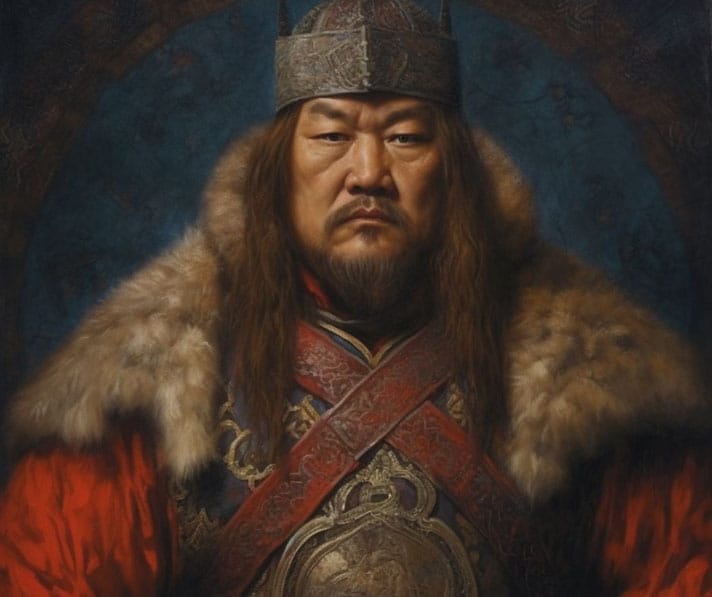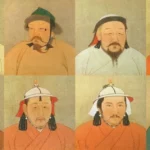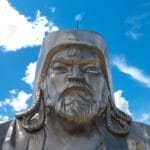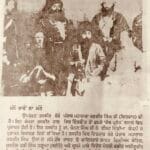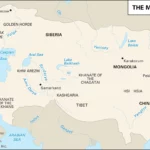Get ready for an epic journey through time! We’re diving deep into the incredible history of Genghis Khan, the legendary founder of the Mongol Empire. From the vast grasslands of Central Asia to the grand palaces of distant lands, we’ll trace the lineage of his descendants and uncover the fascinating stories of those who shaped the world.
Genghis Khan Lineage: A Family Tree That Spans Continents
Genghis Khan, the fierce warrior who built the Mongol Empire, is a legend. But his story doesn’t end with him. Genghis Khan’s descendants, known as the Genghisid lineage, spread his influence far and wide, leaving a mark on history that we can still see today.
So, how did one man’s family tree grow so vast? It’s a story that mixes power, tradition, and maybe even a bit of good luck.
The Chingisid Principle: Power Plays a Part
Genghis Khan wasn’t just a conqueror; he was a savvy ruler. He set up a system called the “Chingisid principle,” which essentially dictated that his sons and their male descendants would inherit leadership roles and a significant portion of the accumulated wealth. This ensured that his family line wasn’t just important symbolically—it was directly tied to power and influence.
Imagine a family business where only your direct descendants get to be CEO – that’s kind of how it worked within the Mongol Empire. This system, combined with the Mongol’s deep respect for strength and social standing, created a fertile environment for Genghis Khan’s family tree to flourish.
More Than One Wife, More Than One Branch
Genghis Khan, like many powerful men of his time, had multiple wives. This practice, called polygyny, meant he fathered many children, each carrying his genes. Think of it like this: more branches on a family tree mean that tree can spread out much further.
And it wasn’t just about Genghis Khan himself. High-ranking Mongol families, eager to link themselves to his power and prestige, strategically arranged marriages with his descendants. This interweaving of lineages further extended the reach of Genghis Khan’s genetic legacy.
DNA Doesn’t Lie: The Science of a Legacy
Here’s where it gets really interesting: scientists have been studying DNA to trace Genghis Khan’s lineage. Astonishingly, they’ve found that roughly 8% of men living in the areas that were once part of the Mongol Empire share a specific genetic marker on their Y chromosomes with Genghis Khan. That’s a lot of potential descendants!
While it’s impossible to be 100% certain without a direct DNA sample from Genghis Khan himself, these findings strongly suggest that his family tree isn’t just a historical curiosity—it’s woven into the very fabric of diverse populations across Asia. This discovery makes you wonder: what other hidden stories might be concealed within our DNA, waiting to be revealed through scientific inquiry?
An Unfinished Story: More to Learn
The tale of Genghis Khan’s lineage is more than just a list of names and dates—it’s a window into the past. It illustrates how culture and genetics intertwine, how societies shape family lines, and how one man’s actions can echo through generations, leaving a lasting impact on human history and our understanding of ourselves.
And the story isn’t over yet. Researchers are still piecing together the finer details of Genghis Khan’s family tree. They’re looking beyond the direct male line, exploring the roles of adopted children and the complexities of intermarriage in expanding his sphere of influence. As we delve deeper into this fascinating lineage, we’re sure to uncover more secrets, challenge long-held assumptions, and gain an even richer understanding of how history, culture, and genetics all play a part in shaping who we are.
Dive into the annals of time and discover the captivating narratives of the past. Check This Out
Am I Descended from Genghis Khan?
So, we’ve established that a surprising number of people might be related to Genghis Khan. But how can we even begin to guess who they might be? The answer, it turns out, could be hidden in a tiny clue passed down through generations – a specific genetic marker on the Y chromosome. Think of it like a family heirloom, but instead of a dusty old pocket watch, it’s a piece of DNA.
Scientists have found this particular genetic marker in a staggering number of men around the world – an estimated 16 million, give or take! That’s like saying one in every 200 men on the planet could be distantly related to the legendary Khan.
Now, before you imagine hordes of horse-mounted warriors in your family tree, it’s crucial to remember that we don’t have a confirmed sample of Genghis Khan’s DNA to compare to. It’s not like archaeologists have unearthed his tomb and swabbed his cheek for a DNA test!
Instead, researchers have pieced together this genetic puzzle by combining historical knowledge with cutting-edge genetic analysis. They know that Genghis Khan was an exceptionally powerful ruler who fathered many children. Add to that the Mongol Empire’s policy of spreading their genes far and wide (sometimes, let’s be honest, not always through peaceful means), and you have a recipe for remarkably widespread genetic influence.
However, it’s important to approach these findings with a degree of caution. Genetic research, much like the study of history itself, is a constantly evolving field. New discoveries have the potential to change our understanding of inheritance patterns and long-ago migration routes.
The story of Genghis Khan’s genetic legacy serves as a fascinating reminder of how historical events, cultural practices, and even an individual’s actions can leave a lasting imprint on the genetic tapestry of humanity. Who knows what other secrets are hidden within our DNA, just waiting to be uncovered by the relentless march of scientific progress?
How is Akbar Related to Genghis Khan?
Akbar the Great, the renowned Mughal Emperor, boasts a family tree with some seriously impressive branches. One branch, in particular, leads directly back to Genghis Khan himself. This connection, established through Akbar’s mother’s side of the family, is a significant detail that adds another layer to our understanding of this historical giant.
It’s not just a cool bit of trivia for family reunions. This ancestral link to the famed Mongol conqueror played a tangible role in shaping Akbar’s reign. It influenced his political strategies and even impacted the overall cultural atmosphere of his time as emperor.
But wait, there’s more! Akbar’s family tree has other fascinating branches. On his father’s side, he can trace his roots back to Timur, also known as Tamerlane, another historical heavyweight renowned for his vast conquests.
Think about it: Mongol heritage on one side, Timurid on the other – talk about a pedigree for a powerful ruler! Akbar inherited the legacy of two of history’s most expansive empires, making him a force to be reckoned with in his own right.
Now, you might be thinking, “How can we be sure about all these family connections from so long ago?” It’s a fair question! Historians painstakingly piece together these intricate family trees using a combination of sources, including written records, inscriptions on ancient monuments, and even cutting-edge analysis of DNA. While it’s impossible to be 100% certain about every single detail, especially when you go so far back in time, the existing evidence strongly supports these links in Akbar’s family history.
And that’s what makes studying history so captivating! It’s like a giant, complex puzzle, and discovering connections like Akbar’s multifaceted ancestry gives us a deeper understanding of his motivations, his policies, and the world he inhabited.
Who Was the Last Descendant of Genghis Khan?
The last known ruler directly descended from Genghis Khan was Sayyid Mir Muhammad Alim Khan. Ruling as the emir of the Uzbek Manghit dynasty, his reign marked the end of an era. When Alim Khan died in 1944, he left no direct male heirs to the throne, seemingly closing that particular chapter of Genghis Khan’s sprawling family tree.
However, to say that marked the absolute end of his lineage is probably an oversimplification. Modern genetic studies have revealed a much broader understanding of ancestry than was previously possible. These studies suggest that Genghis Khan’s Y-chromosome lineage, passed down through the male line, is surprisingly common in many parts of the world. In fact, some researchers estimate that millions of men alive today—perhaps as many as 1 in 200—could be direct descendants of Genghis Khan!
What this tells us is that while we can point to the last person who held a throne as a direct descendant, Genghis Khan’s impact is far from gone. His descendants, both known and unknown, are scattered throughout the world. The Mongol Empire he built left an indelible mark on global history, and its echoes are still felt today, not just in historical records, but also within the very DNA of a vast number of individuals. This just goes to show how complex and interconnected our world truly is, shaped by events and figures from centuries past.
Are Koreans Descended from Genghis Khan?
The relationship between Genghis Khan’s lineage and Korea is a bit of a historical puzzle, filled with intriguing clues and potential connections. While a definitive answer remains elusive, let’s explore what we know so far.
During Korea’s Goryeo dynasty, royal marriages played a crucial role in consolidating power and forming alliances. One particularly noteworthy union was between King Chungnyeol and a daughter of Kublai Khan, the founder of the Yuan dynasty and a direct descendant of Genghis Khan. This marriage formally linked the Korean royal line to the lineage of the legendary Mongol emperor.
But family trees aren’t the only clues hinting at a connection. Scientists studying the genetic makeup of populations have uncovered intriguing evidence as well. They’ve found that a specific Y-chromosome haplogroup, a genetic marker passed down through the male line, found in a significant percentage of Asian men, including Koreans, is also present in individuals known to be descended from Genghis Khan’s paternal line.
Of course, we can’t overlook the impact of the Mongol invasion of Korea in 1231. This tumultuous period led to significant cultural exchange between the two groups. Following the invasion, Korean soldiers fought alongside Mongol armies, Korean artisans and craftsmen brought their skills to Mongolia, and ideas flowed between the two cultures.
While it’s unlikely that all Koreans are directly descended from Genghis Khan, the evidence suggests a complex tapestry of connections woven through royal marriages, intriguing genetic clues, and periods of intense historical interaction. The more we learn, the more captivating this historical puzzle becomes.
What Countries Have Mongolian DNA?
The Mongol Empire, under Genghis Khan’s leadership, stretched across vast swathes of Asia and beyond. Wherever the Mongols traveled and conquered, they left behind more than just footprints—they left behind a genetic legacy that endures to this day.
It’s simple: when people from different groups interact, they have children. Those children inherit a mix of their parents’ genes, passing those genes down to their own children, and so on. So, it’s no surprise that we find traces of Mongolian DNA in a diverse array of countries, particularly those located within the historical boundaries of the Mongol Empire.
We’re talking China, Mongolia (naturally!), Russia, Kazakhstan, and many others. These regions were all within the Mongol Empire’s sphere of influence, places where people from different cultures interacted, sometimes intermarried, and inevitably mixed their genetic material.
Scientists using advanced techniques to trace these genetic connections are becoming increasingly adept at unraveling these intricate patterns of human migration and interaction. They can analyze a person’s DNA and glean clues about where their ancestors might have lived, sometimes reaching back hundreds or even thousands of years.
What they’re finding suggests that the Mongols, despite their relatively small modern population of around 10 million, have left an outsized genetic footprint on the world, a testament to their historical impact.
Of course, we’re still in the early stages of understanding the full extent of this genetic legacy. Every new study seems to uncover new connections and nuances that add to the richness of the story. But one thing is becoming increasingly clear: the Mongol Empire wasn’t just a political powerhouse; it was a genetic force that helped shape the world we live in today.
Is There a DNA Relation to Genghis Khan?
The story of Genghis Khan extends beyond the history books; it’s etched in the very genetic makeup of millions of people alive today.
The Khan’s DNA: A Legacy Written in Our Genes
Scientists have been delving into the secrets held within our DNA, and what they’ve discovered about Genghis Khan is nothing short of astounding. In 2003, a groundbreaking study published in the American Journal of Human Genetics sent shockwaves through the scientific community. The researchers had analyzed DNA samples from thousands of men across Asia, and their findings were remarkable: they discovered a distinct Y-chromosome marker present in a staggering 16 million of those men. This marker, dubbed the “Genghis Khan haplotype,” is thought to have originated with the great Khan himself.
Let that sink in for a moment—16 million people carrying a tiny piece of Genghis Khan’s genetic code! It’s a testament to the enduring power of genetic inheritance and the far-reaching impact of a single individual.
How Did This Happen? The Khan’s Conquest, On a Genetic Level
The sheer scale of Genghis Khan’s genetic legacy might seem unbelievable, but it boils down to a few key factors.
First, Genghis Khan was a ruler on the move. His military campaigns were legendary, and his empire sprawled across vast territories. This widespread movement created ample opportunities for his lineage to, shall we say, disseminate.
Second, Genghis Khan had many wives, a practice known as polygyny that was common among powerful rulers of the time. Each wife represented a new branch of his family tree, a new lineage through which his genes could be passed down. This, combined with his military successes, contributed to the widespread presence of his Y-chromosome marker.
A Few Caveats: DNA Evidence and Historical Puzzles
It’s important to acknowledge that, as of right now, we haven’t located Genghis Khan’s tomb. Without a confirmed sample of his DNA, it’s impossible to say with absolute certainty that the “Genghis Khan haplotype” originated with him. However, based on the available genetic evidence, his historical dominance, and his prolific nature, it’s the most likely explanation. Think of it as a historical puzzle where we’ve assembled most of the pieces, and they paint a pretty compelling picture.
The Quest Continues: Unraveling the Mysteries of the Khan’s DNA
Scientists aren’t content to leave mysteries unsolved. Research into Genghis Khan’s genetic legacy is ongoing, with researchers delving into intriguing questions about the diversity within his descendants, the impact of regional variations, and the long-term effects of centuries of intermarriage.
Here’s a quick recap:
- Millions of men alive today might be descended from Genghis Khan based on the prevalence of a specific DNA marker.
- His military prowess and, let’s face it, his numerous wives, created the conditions for his genes to spread far and wide.
- We haven’t yet found Genghis Khan’s actual DNA, so our understanding is based on robust evidence and educated deduction.
- Scientists are diligently working to unlock the full scope and implications of the Khan’s remarkable genetic legacy.
Genghis Khan’s story is a captivating blend of history, genetics, and the enduring connections we share with the past. Who knows what other secrets we might uncover as scientists continue their exploration?
How Do You Know if You Are a Descendant of Royalty?
Have you ever wondered if there’s a crown or two hidden somewhere in your family tree? The desire to unearth a royal connection in our ancestry is a common one. While it’s not always as simple as following a treasure map, uncovering a regal ancestor can be a thrilling endeavor.
Let’s circle back to Genghis Khan for a moment. As we’ve seen, he had a lot of descendants. Some researchers estimate that his genes are carried by millions of men around the world. Now, before you start practicing your royal wave, remember that proving a direct link to such a prominent figure from the 13th century requires meticulous research and a bit of luck.
Tracing royal lineage is like assembling a complex puzzle, and some pieces might be lost to time. Here’s how to channel your inner historian and embark on your own royal ancestry quest:
1. Start with Your Family Tree:
- Gather Information: Talk to older relatives, collect any existing family trees or documents, and note down surnames as far back as you can go. Certain names might be associated with noble families or even royalty itself.
- Look for Clues: Pay attention to places where your ancestors lived. Were there any royal residences or estates nearby? Did your family possess any heirlooms or stories that hint at a connection to a particular royal line?
2. Dive into Historical Records:
- Explore Archives: Public archives, libraries, and online databases can be treasure troves of information. Search for birth, marriage, and death records, land deeds, wills, and even court documents that mention your ancestors.
- Think Outside the Box: Don’t limit your search to obvious sources. Church records, military rosters, and even passenger lists from ships can hold valuable clues about your family history.
3. Remember, Royalty Isn’t Limited to Europe:
- Broaden Your Horizons: Royal families have existed throughout history and across the globe. Consider potential connections to rulers and nobles from Asia, Africa, the Middle East, and the Americas.
4. Be Patient and Persistent:
- Enjoy the Journey: Uncovering your family history is a journey of discovery, and it takes time. Don’t be discouraged if you don’t find a royal ancestor right away. Each piece of information you uncover adds to the richness of your family story.
What Race Was Genghis Khan?
Unraveling Genghis Khan’s racial identity presents unique challenges, as our modern understanding of race doesn’t easily map onto the world he inhabited. So, how do we approach this complex question?
Genghis Khan was born in the heart of Central Asia, sometime around 1162. The vast steppes were home to numerous nomadic groups, and Genghis Khan belonged to the Mongols. While the concept of “race” as we understand it today didn’t exist in the same way, the Mongols were a distinct ethnic group with their own language, traditions, cultural practices, and sense of identity, aligning with East Asian cultural spheres.
Attempting to categorize Genghis Khan using modern racial categories is an inherently flawed exercise. These categories are often based on socially constructed notions rather than fixed biological realities.
What we can say with certainty is that Genghis Khan’s ancestry was deeply rooted in the Mongol people. His family tree would reveal generations of individuals who lived and identified as Mongols. They shared a common language, cultural heritage, and way of life.
Adding another layer of complexity, Genghis Khan’s empire encompassed a staggering diversity of people and cultures. Stretching from Eastern Europe to East Asia, the Mongol Empire facilitated the movement and intermingling of populations across a vast geographical area.
Modern genetic studies offer fascinating glimpses into the impact of this historical mixing. Research suggests that millions of people around the world, particularly in regions once part of the Mongol Empire, carry genetic markers indicative of Mongol ancestry.
While we may never know Genghis Khan’s “race” in the modern sense, we can appreciate the complexity of his identity and the echoes of his legacy that continue to resonate through history and within the genetic makeup of humanity.
How Do You Know if You’re a Descendant of Prophet Muhammad?
The desire to trace one’s lineage back to significant historical figures is a common thread that connects us to the past. For those of Islamic faith, the possibility of being descended from Prophet Muhammad holds particular significance.
Following the Family Tree Back in Time
Prophet Muhammad’s family tree is meticulously documented in Islamic tradition, stretching back through his father to Adnan, a descendant of Ishmael (the son of Abraham). This lineage, known as the Adnanite lineage, is carefully preserved in numerous historical texts and genealogical records.
Here’s a simplified approach to exploring this connection:
- Start with Your Paternal Line: Focus on your father’s side of the family, as the most direct line back to Prophet Muhammad would be through male ancestors. Talk to older relatives, gather any existing family trees, and record names and birthplaces as far back as possible.
- Consult Genealogical Resources: Numerous books, scholarly articles, and online databases are dedicated to Islamic genealogy, particularly the lineage of Prophet Muhammad. These resources can provide information about his descendants and their family lines.
- Look for a Match: Compare your family tree, focusing on your direct paternal line, to the established lineage of Prophet Muhammad. If you find a match—that is, an ancestor’s name and information that aligns with his documented descendants—it could indicate a connection.
DNA Testing: A Modern Tool for Ancient Ties
Advances in DNA technology have opened up new avenues for tracing ancestry. The Y chromosome, passed down from father to son, can be particularly revealing. While Prophet Muhammad didn’t have any sons who lived to adulthood, his grandsons (through his daughter Fatima) carried his Y-chromosome lineage.
Modern DNA testing can compare your Y-chromosome profile to those of known descendants of Prophet Muhammad to see if there’s a match. Think of it like searching for a genetic signature that links you to his paternal line.
The Mystery of the Maternal Line
Tracing ancestry through your mother’s side is more challenging. Unlike the Y chromosome, which is passed down relatively unchanged from father to son, mitochondrial DNA (mtDNA), inherited from the mother, undergoes more complex mixing over generations. While mtDNA testing can provide insights into your maternal ancestry, tracing it back directly to Prophet Muhammad is extremely difficult using current technology.
A Few Things to Consider
- Ongoing Research: The field of genetics is constantly evolving. New discoveries and refinements in testing methods are continually expanding our understanding of ancestry.
- Not 100% Certain: Even with thorough genealogical research and DNA testing, tracing ancestry back centuries always involves a degree of uncertainty. Records can be incomplete, family stories might contain inaccuracies, and DNA can mutate over time.
- A Journey of Discovery: The true value of exploring your roots lies in the journey of discovery. Regardless of whether you confirm a direct link to Prophet Muhammad, you’re bound to uncover fascinating stories about your family’s past.
This article is just a starting point. For those interested in delving deeper, consider consulting with genealogists specializing in Islamic lineage and researching reputable genetic testing options.
- China II Review: Delicious Food & Speedy Service - April 17, 2025
- Understand Virginia’s Flag: History & Debate - April 17, 2025
- Explore Long Island’s Map: Unique Regions & Insights - April 17, 2025
